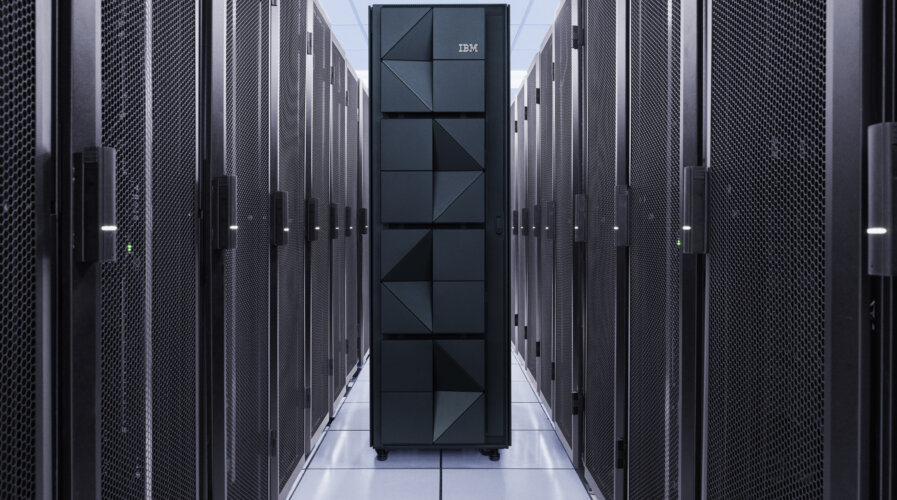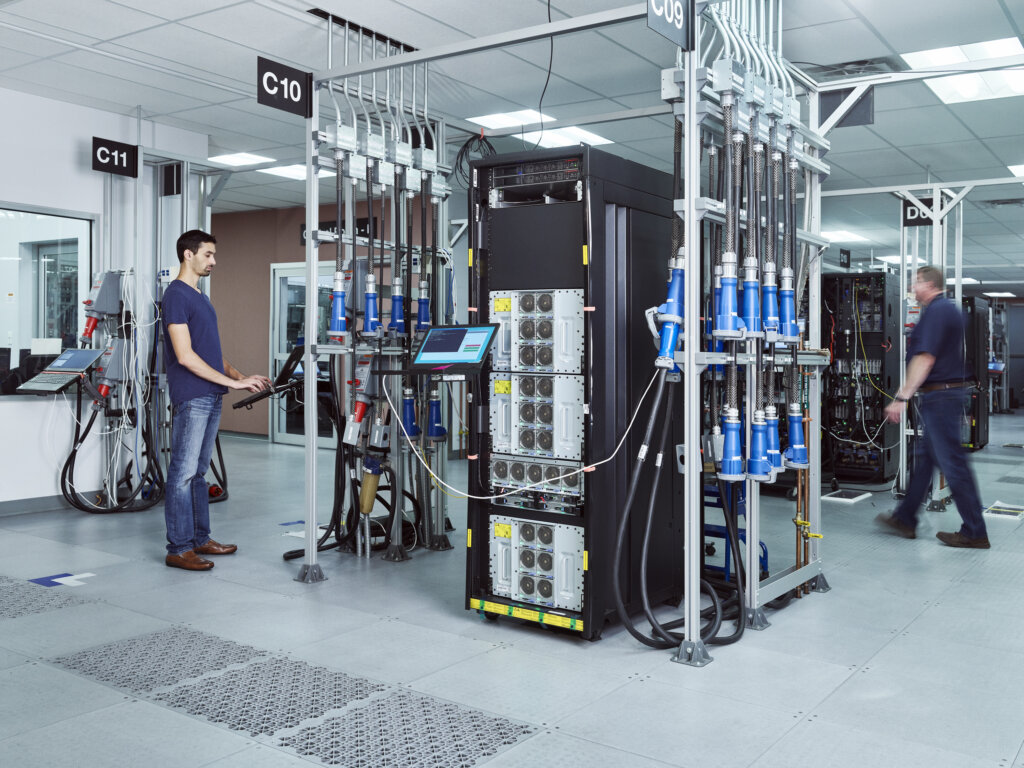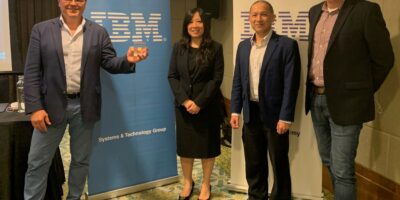
(Source – IBM)
IBM z16 reduces complexities of the hybrid cloud in the financial industry
Are mainframes still relevant? For folks in the tech industry, despite the increasing growth in cloud adoption, the mainframe still has an important role to play in keeping businesses afloat. For many, the mainframe not only represents a pre-cloud era but is still an important component of an organization’s IT setup.
There is no denying that cloud computing has revolutionized digitalization and enabled companies to do a lot more than they ever could. Yet, the mainframe is still a key component in ensuring they are able to run their business workloads properly with minimal disruptions.
In fact, according to a recent IBM study, 71% of IT executives surveyed feel that critical mainframe-based applications are still central to their business strategy. The study also highlighted that the percentage of organizations leveraging mainframe assets in a hybrid cloud environment could increase more than two-fold.
Looking at specific industries, the financial industry would most likely be the most relevant industry to continue leveraging its mainframe while enjoying the capabilities offered by the cloud. The IBM z16, which was unveiled last year, is now enabling organizations, especially those in the financial industry to embrace modernization with minimal complexities.
Simply put, the IBM z16 brings AI and cyber resiliency into the hybrid cloud by using innovative on-chip AI inferencing and quantum-safe technologies. It can accelerate decision velocity and provide the agility needed for business to move forward. It is also the world’s first system with the computing power and intelligent infrastructure to prevent fraud in real-time at scale – a cross-industry challenge that, for example, cost financial services institutions US$32 billion in card losses in 2021.
With the ability to analyze and process more than 300 billion high-value transactions with just one millisecond of latency, this next-generation IBM zSystem features a multitude of industry-first breakthroughs. This includes deep-learning inferencing (AI) for mission-critical workloads like credit cards, healthcare, and financial transactions. BNP Paribas for example has been able to innovate its core systems that reside on Z. It opens up to APIs, enabling a developer to be the cloud and write an application via z16.
“You can have a developer on native cloud on AWS, Azure, or IBM Cloud, writing an application calling an API on Z. The developer never knows it’s Z API, but only knows that it’s asking for data. That’s powerful. And that’s how organizations like BNP Paribas are doing,” explained Jose Castano, Vice President WW Sales IBM Z & LinuxOne.
What makes this possible is the IBM Telum processor. The Telum processor is IBM’s first processor to contain on-chip acceleration for AI inferencing while a transaction is taking place. This allows clients to apply this first-in-industry integrated accelerator to their enterprise AI workloads. The on-chip AI design unlocks the low latency inferencing necessary to analyze transactions as they happen to prevent fraud in real-time and at a massive scale.

(Source – IBM)
IBM z16 in the financial industry
According to Castano, in the financial industry, the z16 mainframe can help with loan approvals by helping to speed up approval of business or consumer loans from days to hours or minutes. It can also assist in clearing and settlement by determining which trades and/or transactions may have a high-risk exposure before settlement as well as designing better model risk against fraud and theft.
Specifically, when it comes to banking and the financial industry, IBM z16 can:
- Predict and automate with accelerated AI1 – Prevent fraud before it happens by scoring up to 100% of credit card transactions in real time.
- Secure with a cyber resilient system – Defend against ransomware and cyberwar; show audit-ready compliance in days not weeks; automatically move workloads in minutes if disaster strikes.
- Modernize with hybrid cloud – Enhance customer experiences through fast cloud integrations, existing skills, and familiar tools.
In Malaysia, Catherine Lian, Managing Director and Technology Leader of IBM Malaysia pointed out that with over 70% of the global transaction value running on IBM zSytems, the top banks in Malaysia are relying on IBM’s mainframe, showing a significant penetration in the financial market in the country. Recipients of Malaysia’s digital banking licenses are also leveraging z16, which Lian believes will allow IBM to build a whole resiliency strategy with them. This will enable IBM to offer its unmatched security offerings and brand agility.
For Lian, success in the digital economy is contingent on making IT a creator of value— internally and externally. Fundamental to this is a flexible infrastructure that positions organizations strategically, leveraging AI and hybrid cloud while protecting existing investments and improving sustainability.
“The IBM z16 platform delivers this with scale, agility, resiliency, performance, a security-rich environment IBM z16 gives businesses across industries in Malaysia the confidence to build the future of their business,” concluded Lian.

Jose Castano, Vice President WW Sales IBM Z & LinuxOne and Catherine Lian, Managing Director and Technology Leader, IBM Malaysia
Mainframes are here to stay
Castano also pointed out that IBM z16 allows clients to fully embrace the hybrid cloud by empowering developers to modernize existing data and applications that reside on IBM z16 with new digital services across complex, multi-cloud environments. For decades, key industries have turned to IBM zSystems and IBM storage to manage transactions and store customer data, with IBM partnering with some of the largest banking, insurance, public sector, and healthcare institutions – including two-thirds of the Fortune 100.
When it comes to security, Castano also highlighted that the z16 represents the industry’s first quantum-safe system, underpinned by lattice-based cryptography – an approach for constructing security primitives that helps protect data and systems against current and future threats. For background, quantum-safe cryptography refers to efforts to identify algorithms that are resistant to attacks by both classical and near-future capabilities of quantum computers, to keep information assets secure even after a large-scale quantum computer has been built.
“The global economy runs on the mainframe. If all mainframes were to stop today, you couldn’t use your credit card. You won’t be able to work with your bank or even reserve an airline ticket or even claim insurance. It’s a global economy. We have all the stats and public references for this. And this is what the z16 is about. It’s about modernization and security with the hybrid cloud,” explained Castano.
READ MORE
- 3 Steps to Successfully Automate Copilot for Microsoft 365 Implementation
- Trustworthy AI – the Promise of Enterprise-Friendly Generative Machine Learning with Dell and NVIDIA
- Strategies for Democratizing GenAI
- The criticality of endpoint management in cybersecurity and operations
- Ethical AI: The renewed importance of safeguarding data and customer privacy in Generative AI applications


